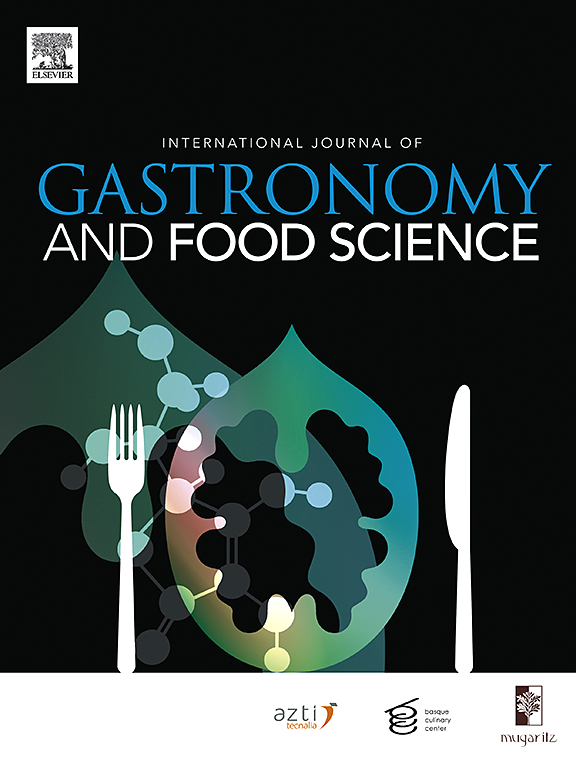Time-course analysis of kobujime curing of Japanese flounder (Paralichthys olivaceus): Biochemical insights into dehydration processing of fish meat with kombu
IF 3.2
2区 农林科学
Q2 FOOD SCIENCE & TECHNOLOGY
International Journal of Gastronomy and Food Science
Pub Date : 2025-01-30
DOI:10.1016/j.ijgfs.2025.101124
引用次数: 0
Abstract
The demand for sustainable and healthy food processing methods is increasing, and kobujime, a traditional Japanese seafood processing technique, may offer a solution. This method involves dehydrating fish meat with dried kombu (kelp). The present study investigated the relationship between dehydration and biochemical characteristics in Japanese flounder (Paralichthys olivaceus) meat during kobujime curing, aiming to elucidate its preservation and umamification mechanisms. Flounder meat samples were prepared in three ways: non-dehydrated, dehydrated with a commercial dehydrator sheet, and dehydrated with dried kombu (kobujime). The transfer of Na+ and free Glu to the flounder meat was observed exclusively in the kobujime curing. Analysis of taste substances and metabolomic profiles suggested that dehydration with both the dehydrator sheet and the kombu not only concentrates metabolites but also alters biochemical reactions in the flounder meat. Furthermore, the transfer of flavors from the kombu to the flounder meat was indicated.
海带熏制牙鲆的时程分析:海带对鱼肉脱水加工的生化意义
对可持续和健康的食品加工方法的需求正在增加,而日本传统的海鲜加工技术kobujime可能提供一个解决方案。这种方法包括用干海带使鱼肉脱水。本研究对日本比目鱼肉在蒸熟过程中脱水与生化特性的关系进行了研究,旨在阐明其保鲜保鲜机理。比目鱼肉样品采用三种方法制备:不脱水、用商业脱水机片脱水和用干海带(kobujime)脱水。Na+和游离Glu在比目鱼肉中的转移仅在kobujime腌制过程中观察到。风味物质和代谢组学分析表明,脱水机片和海带脱水不仅使比目鱼肉的代谢物浓缩,而且改变了比目鱼肉的生化反应。此外,还指出了从海带到比目鱼肉的风味转移。
本文章由计算机程序翻译,如有差异,请以英文原文为准。
求助全文
约1分钟内获得全文
求助全文
来源期刊

International Journal of Gastronomy and Food Science
Social Sciences-Cultural Studies
CiteScore
5.30
自引率
10.50%
发文量
170
审稿时长
45 days
期刊介绍:
International Journal of Gastronomy and Food Science is a peer-reviewed journal that explicitly focuses on the interface of food science and gastronomy. Articles focusing only on food science will not be considered. This journal equally encourages both scientists and chefs to publish original scientific papers, review articles and original culinary works. We seek articles with clear evidence of this interaction. From a scientific perspective, this publication aims to become the home for research from the whole community of food science and gastronomy.
IJGFS explores all aspects related to the growing field of the interaction of gastronomy and food science, in areas such as food chemistry, food technology and culinary techniques, food microbiology, genetics, sensory science, neuroscience, psychology, culinary concepts, culinary trends, and gastronomic experience (all the elements that contribute to the appreciation and enjoyment of the meal. Also relevant is research on science-based educational programs in gastronomy, anthropology, gastronomic history and food sociology. All these areas of knowledge are crucial to gastronomy, as they contribute to a better understanding of this broad term and its practical implications for science and society.
 求助内容:
求助内容: 应助结果提醒方式:
应助结果提醒方式:


